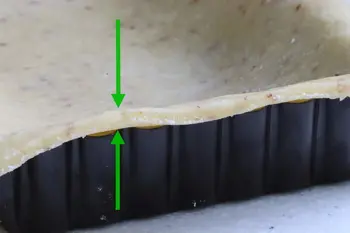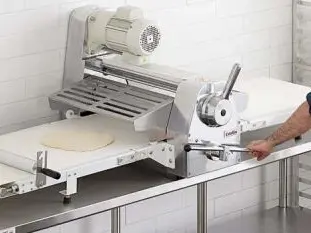How to properly roll out a pie crust?

Very often in pastry making, you have to roll out a pastry before using it for a pie or another dessert.
At home, of course, you get out your rolling pin and simply roll it out.
Is there a way to get an evenly rolled out dough? That's what we will see in this article.
At home, of course, you get out your rolling pin and simply roll it out.
Is there a way to get an evenly rolled out dough? That's what we will see in this article.
10 K 4.9/5 (16 reviews)
Keywords for this post:PastryDoughRollWedgesThicknessRegularThinLast modified on: May 10th 2023
How to properly roll out a pie crust?

To make a good pie, you need to have a pastry (shortcrust, shortbread, sweet or other...) that is rolled out thinly, i.e. about 3 mm thick.
It must be rolled out thinly, but also regularly, in other words the thickness must be the same on the whole surface of the dough.
It's not that easy to roll out a dough evenly, and the professionals who do it often work with a rather extraordinary machine called a rolling mill: The dough is pushed by an automatic belt between 2 metal cylinders of adjustable thickness.

At home, there is no secret, you have to work with a roller and therefore spread your dough a little by eye to determine the right thickness, and be as regular as possible.
Can we improve this?
Yes, and with a very simple and inexpensive tool, the pastry wedges.As their name indicates, they are very simple blocks, in different materials, metal, silicone, wood... and of fixed thickness, often 3, 5 and 10 mm.

To use them, you just have to start rolling out as usual, then when you are close to the chosen thickness, put the wedges around the dough, and pass the rolling pin by leaning on the wedges.

This way, the roller can't go lower than the wedges, and your dough can't go lower in thickness than the wedges.
It's both very simple and very effective, so don't hesitate to try it.
To sum up: To roll out a dough evenly, nothing is more practical than pastry blocks of the chosen thickness.
Lasts posts
Butter vs. grease
We often read in a recipe where a pastry is put into a mould that, just before pouring, the mould should be buttered or greased. But what's the difference between these 2 terms?December 1st 20258595
Getting out of the fridge early
Very often when you're cooking, you need to take food or preparations out of the fridge, to use them in the recipe in progress. There's nothing tricky about this: you just take them out of the fridge and use them, usually immediately, in the recipe. But is this really a good method?November 24th 20251,0375
Who's making the croissants?
When you look at a bakery from the outside, you naturally think that in the bakery, the bakers make the bread, and in the laboratory, the pastry chefs make the cakes. It's very often like that, with each of these professions having quite different ways of working, but sometimes there's also one...November 23th 2025932
Oven height
When we put a dish or cake in the oven, we naturally tend to put it on the middle shelf, and that's what we usually do. But in some cases, this position and height can be a little tricky, so let's find out why.October 8th 20252,5785
The importance of sieving
In recipes that use a fine powder (flour, powdered sugar, etc.), you'll often see the advice to sift before using it. To sift is to pass the powder in question through a sieve (a very fine strainer) before incorporating it into your recipe. It's often advice, but is it really useful?September 3rd 20257,4343
Other pages you may also like
The 3 secrets of successful mousses
When you make a traditional mousse, that is to say without using a siphon, whatever the recipe, it's always the same principle: on one side you have a dense mixture, very tasty, and on the other side egg whites beaten until stiff. All the difficulty of the success of a mousse, it will be to mix the...April 3rd 20219,7684.6
The return of the "Norman hole"
You maybe know the "trou normand", this old gastronomic custom typically French which consists in taking a (small) glass of calvados, generally between the last course and the dessert? It's something that seems a bit anachronistic nowadays, having a glass of an alcohol of more than 60° in the...December 18th 202115 K4.8
Well-cooked meat
Have you ever noticed that if you like your meat well done, it invites strange looks? For instance, in a restaurant, when asked “How would you like that cooked?” If you reply, “Well done,” it is almost as if you are swearing….May 21th 201134 K 14.4
The bitterness of endives
As I write these lines, we are entering the endive season, and if you like it, it's time to enjoy it, if possible with your local producers. Endive is good, but the reproach that is often made of it, and children in particular, is: "It's bitter! And it is (somewhat) true of course, endives...February 9th 201914 K4.9
How to break eggs properly?
It is a very common gesture in pastry, bakery and of course cooking: breaking eggs to incorporate them into a recipe. You have eggs (which professionals call "shell eggs" to differentiate them from liquid eggs in cartons or cans), and you must break them to incorporate the contents into your...June 26th 202115 K4.8
Post a comment or question
Follow this page
If you are interested in this page, you can "follow" it, by entering your email address here. You will then receive a notification immediately each time the page is modified or a new comment is added. Please note that you will need to confirm this following.
Note: We'll never share your e-mail address with anyone else.
Alternatively: you can subscribe to the mailing list of cooling-ez.com , you will receive a e-mail for each new recipe published on the site.









